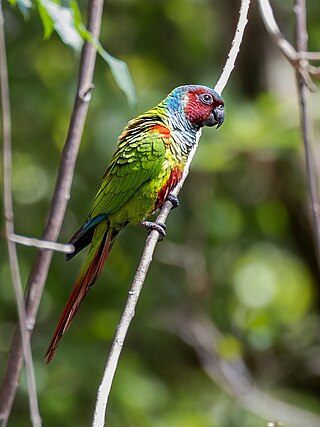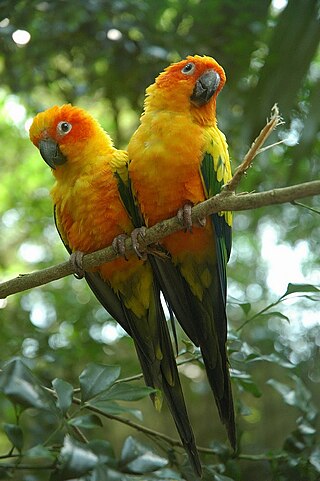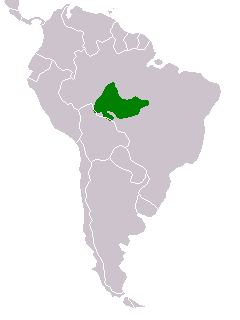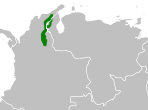
The green-cheeked parakeet, known as the green-cheeked conure in aviculture, is a species of bird in subfamily Arinae of the family Psittacidae, the African and New World parrots. It is found in Argentina, Bolivia, Brazil, and Paraguay.

The neotropical parrots or New World parrots comprise about 150 species in 32 genera found throughout South and Central America, Mexico, the Caribbean islands and the southern United States. Among them are some of the most familiar and iconic parrots, including the blue and gold macaw, sun conure, and yellow-headed amazon.

Aratinga is a genus of South American conures. Most are predominantly green, although a few are predominantly yellow or orange. They are social and commonly seen in groups in the wild. In Brazil, the popular name of several species usually is jandaia, sometimes written as jandaya in the scientific form.

The golden parakeet or golden conure, or the Queen of Bavaria conure is a medium-sized golden-yellow Neotropical parrot native to the Amazon Basin of interior northern Brazil. It is the only species placed in the genus Guaruba.

Pyrrhura is a genus of parrots in the Arini tribe. They occur in tropical and subtropical South America and southern Central America. Most are restricted to humid forest and adjacent habitats, but one species, the blaze-winged parakeet, prefers deciduous or gallery woodland, and another, the Pfrimer's parakeet, is restricted to dry regions. Some species are highly endangered.

The maroon-bellied parakeet is a small parrot found from southeastern Brazil to north-eastern Argentina, including eastern Paraguay and Uruguay. It is also known as the reddish-bellied parakeet, and in aviculture it is usually referred to as the maroon-bellied conure, reddish-bellied conure or brown-eared conure.

The jandaya parakeet or jenday conure is a small Neotropical parrot with green wings and tail, reddish-orange body, yellow head and neck, orange cheeks, and black bill, native to wooded habitats in northeastern Brazil. It is a member of the Aratinga solstitialis complex of parakeets very closely related to, and possibly subspecies of the sun parakeet.

The fiery-shouldered parakeet, also known as the fiery-shouldered conure, is a species of parrot in the family Psittacidae. It is found in Brazil, Guyana, and Venezuela. Its natural habitat is subtropical or tropical moist montane forests. There are two subspecies, P. e. egregia and P. e. obscura.

The pearly parakeet, known as the pearly conure in aviculture, is a Vulnerable species in subfamily Arinae of the family Psittacidae, the African and New World parrots. It is endemic to Brazil.

The crimson-bellied parakeet, known as the crimson-bellied conure in aviculture, is a species of bird in subfamily Arinae of the family Psittacidae, the African and New World parrots. It is found in Bolivia and Brazil.

The painted parakeet, known as the painted conure in aviculture, is a species of bird in subfamily Arinae of the family Psittacidae, the African and New World parrots. It is found in Brazil, Colombia, French Guiana, Guyana, Panama, Suriname, and Venezuela.

The grey-breasted parakeet is an Endangered species of bird in subfamily Arinae of the family Psittacidae, the African and New World parrots. It is endemic to Ceará in northeastern Brazil.

Pfrimer's parakeet is a non-migratory species within the parrot family Psittacidae. It also is known as Pfrimer's conure, Goias parakeet, and maroon-faced conure. The Pfrimer's parakeet has been qualified as endangered by the IUCN and BirdLife International since 2007. It is endemic to the Goiás and Tocantins regions of Brazil. It is mainly found within a belt of dry deciduous and semi-deciduous areas of the Caatinga forest.

The rose-fronted parakeet, known as the rose-fronted conure in aviculture, is a species of bird in the subfamily Arinae of the family Psittacidae, the African and New World parrots. It is found in Bolivia, Brazil, Ecuador, and Peru.

Bonaparte's parakeet, also known as Deville's parakeet, or in aviculture as Deville's conure, is a species of parrot in the family Psittacidae. It is restricted to the Brazilian state of Amazonas south of the Solimões river.

The sun conure, also known as the sun parakeet, is a medium-sized, vibrantly colored parrot native to northeastern South America. The adult male and female are similar in appearance, with black beaks, predominantly golden-yellow plumage, orange-flushed underparts and face, and green and blue-tipped wings and tails. Sun conures are very social birds, typically living in flocks. They form monogamous pairs for reproduction, and nest in palm cavities in the tropics. Sun conures mainly feed on fruits, flowers, berries, blossoms, seeds, nuts, and insects. Conures are commonly bred and kept in aviculture and may live up to 30 years. This species is currently threatened by loss of habitat and trapping for plumage or the pet trade. Sun conures are now listed as endangered by the International Union for Conservation of Nature.

The Madeira parakeet, also known as the Madeira conure is a species of parrot found in Brazil and Bolivia. It is found in the eastern and central Amazon basin south of the Amazon River and can be found in várzea forests. It prefers habitats with bamboo along waterways, it also enjoys clearings in dense forests. It was named after Emilie Snethlage.

The Venezuelan parakeet or Emma's conure is a species of bird in subfamily Arinae of the family Psittacidae, the African and New World parrots. It is endemic to Venezuela.

The Perija parakeet, also known as Todd's parakeet or in aviculture as Perijá conure, is a species of parrot in the family Psittacidae. There are about 1000 to 2499 living individuals with a decreasing population trend. In 2001 the Perija parakeet was reclassified from a subspecies of the painted parakeet to an individual species. There are two subspecies of the Perija parakeet, P. c. caeruliceps and P. c. pantchenko. P. c. caeruliceps lives in Sierra de Perijá mountains on the northern border between Columbia and Venezuela. P. c. pantchenko lives in the Perijá Mountains.





















